Volkswagen Tiguan 2.0 TFSI 4Motion
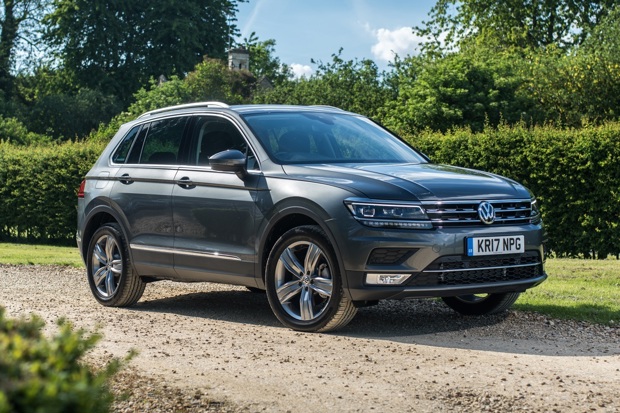
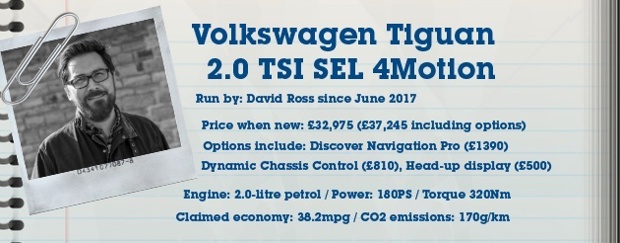
- Fifty shades of Volkswagen grey
- Why we chose a petrol rather than diesel Tiguan...
- The perfect family car?
- Volkswagen hits the infotainment nail on the head
- Is it time for a plug-in hybrid Tiguan?
- Thule roof box to the rescue
- An optional extra that I never ever use
- Is the Ateca a better choice than our Tiguan?
- Can boring actually be a good thing?
- Dynamic chassis control - a worthwhile extra?
- A Tiguan with seven seats - that will be the Allspace
- We say goodbye after six months with our Tiguan
Fifty shades of Volkswagen grey
At more than £35,000, the Tiguan is one expensive crossover - even for a Volkswagen - so is it worth the money?

Date: 1 June 2017 | Current mileage: 233 | Claimed economy: 38.2mpg | Actual economy: 29.2mpg
I live on a new(ish) housing development. We used to call them estates when I was younger but apparently it's a 'development' now. As new areas go, it's quite a nice one. It's on the site of what was once a Victorian hospital, which has now been turned into luxury apartments complete with a posh gym and spa. Of course. And on what were the grounds there are now lots of houses.
As you'd expect. It's all very middle England with very polite neighbours who keep their gardens impeccable and have John Lewis lorries delivering things during the week. And the cars on the driveways reflect this. The Discovery Sport is a particular favourite as is the Qashqai. Plus lots of Audi Q3s and BMW X1s.
And now it seems like we've joined the hordes with our new arrival - the Volkswagen Tiguan. If any car says 'middle class family' this is it. It's even grey (Indium Grey metallic actually) so it blends in. You don't want to create an eyesore after all.
The Tiguan covers the middle ground when it comes to crossovers. It's image may not be as premium as a BMW, but it's a cut above a Honda or a Nissan. Which is certainly reflected in the price. Our Tiguan is a high spec SEL model but even with that considered, it's still expensive at £32,975.
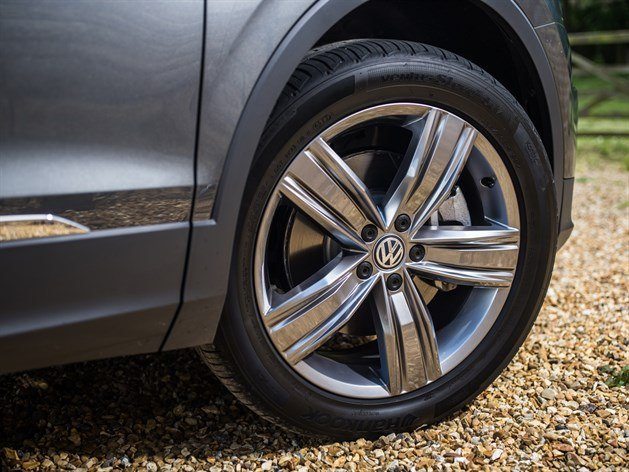
SEL models come with sleek 19-inch alloys as standard
That's not to say you have to spend this much. The Tiguan range starts at £23,250 for a 1.4 TSI in basic S trim. But judging by the other Tiguans I've seen on the roads of late, it's the SEL and R Line models that people are buying. And both of those start at more than £30k.
So does it justify that price tag? Well you certainly get plenty for your money in terms of standard equipment. Our car comes with 19-inch alloy wheels (which complement the grey paintwork really well), a full length panoramic glass roof, which is proving very popular with our two-year-old daughter, navigation and adaptive cruise control. Just to mention a few.
In fact the only things it doesn't come with which you might expect of a high spec model are leather seats - a £1500 option - and a reversing camera, which is another £300. Saying that, we were still able to somehow add on more than £4000 of optional extras including the head-up display, an electric tailgate with the keyless entry package, Dynamic Chassis Control (an eye-watering £810) and the upgraded Discover Navigation Pro which was the most expensive addition at £1390.
The one thing the Tiguan certainly does not feel is cheap. It has a quality interior with a premium feel to it, from the lovely leather steering wheel with its piano black inserts to the Active Info Display - a high res screen that replaces the conventional instrument dials. Everything works with real precision and a rewarding weight. So early impressions are very favourable. Will that last? We have six months to find out.
Why we chose a petrol rather than diesel Tiguan...
The vast majority of Tiguan models on the road are TDI diesels. But we've gone for the less economical TSI. Here's why.

Date: 15 June 2017 | Current mileage: 482 | Claimed economy: 38.2mpg | Actual economy: 30.2mpg
Diesel is getting a lot of bad press at the moment. Especially anything to do with Volkswagen diesels. Yet there's no denying that, for a large proportion of drivers, a diesel engine makes sense. If you're sitting on the motorway all day and covering more than 10,000 miles a year, chances are a diesel will be the best choice if you want to keep costs down.
It wasn't that long ago that many SUVs and the like only came with diesel engines. With a petrol reserved for the high performance version. But things are changing - as our Tiguan shows. While the TDI may account for the majority of models on the road, there's an ever expanding petrol line-up.
You can now get a 1.4 TSI petrol - an engine that's used in a whole variety of cars from the Skoda Kodiaq to the SEAT Leon. In fact, it's the engine we had in the Audi Q3 I ran previously. It comes as a two-wheel drive only, but for most people, the absence of 4Motion will make very little difference in everyday driving. In fact, it's a benefit due to better fuel economy.
When we ordered our Tiguan, the 1.4 TSI wasn't available. So we opted for the 2.0 TSI which comes with 4Motion four-wheel drive. It's not actually that much more powerful than the 1.4-litre with 180PS but does have more torque with an extra 70Nm.
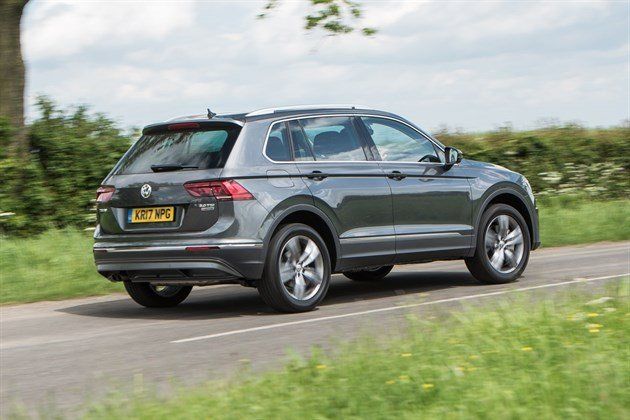
The 2.0 TSI in our Tiguan is proving to be incredibly quiet
So why did we chose a TSI rather than the diesel? Well firstly there's the maths part. We only cover around 8000 miles a year - not enough to see any return on the extra cost of the TDI 190 which carries a £1770 premium. Comparable claimed economy? Well it's 49.6mpg for the diesel compared to 38.2mpg for the TSI.
That said, there is a 150PS version of the same 2.0 TDI which is cheaper (if you forego the 4Motion four-wheel drive) and official economy improves to 57.6mpg. Enough to convince us into a diesel? Not quite. Our Tiguan spends most of its time covering lots of short journeys and is rarely on dual carriageways or motorways. A diesel is not designed for this kind of driving and it means you're asking for DPF problems sooner rather than later.
It's not just money though. Personally, I prefer a petrol engine for around town driving. The 2.0 TSI in our Tiguan is incredibly quiet and smooth and with the DSG automatic gearbox, it makes it an effortless car to drive. It may lack torque on the motorway which means you have to work it to get decent in-gear acceleration, but when sat in traffic (which is far more common for me...) you can barely tell the engine is running.
I am tempted to get a drive in a 1.4 TSI to compare it to the 2.0 TSI in our car. At £29,900 in SEL trim it's more than £3k cheaper than our car. But it will have to be very good to tempt me away from the excellent 2.0 TSI.
The perfect family car?
Cool. Calm. Connected. That's how Volkswagen describes the Tiguan. But is it still cool and calm when tasked with daily family life?
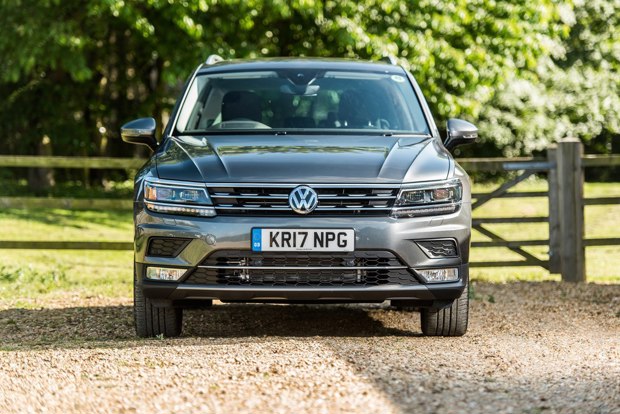
Date: 3 July 2017 | Current mileage: 708 | Claimed economy: 38.2mpg | Actual economy: 29.0mpg
I'm fortunate that, given the nature of my job, I get to drive all sorts of cars - from budget Dacia hatchbacks to high performance sports cars with a price tag to make your eyes water. And everything in between. But when it comes to having a car to drive everyday - and transport the family around in - a different set of priorities takes over.
We describe the Tiguan as a 'family car'. A generic term sure, but then for many people, price is what drives their choice of car, whether it be an outright figure or a monthly PCP amount. Yes, this is a crossover - and a very good one at that - but there's nothing to say that someone considering a Tiguan wouldn't also be looking at a wider range of cars. Stuff like the Skoda Superb Estate or a Ford S-MAX for example.
So why do people choose crossovers? Personally, I've never been a huge fan of the looks nor the driving style. But they have grown on me and the latest crop on the market - things like the Peugeot 3008, Hyundai Tucson and SEAT Ateca - are very impressive. I can certainly see the appeal of those and there's one thing they all offer - space.
Now I know that's not that exciting, but it makes a big difference. We only have one two-year old but the amount of stuff that accompanies her most places would give a U2 world tour a run for its money. And they probably don't have to carry a baby blue play pushchair around. If that doesn't come with us, it can start a meltdown to rival Chernobyl.
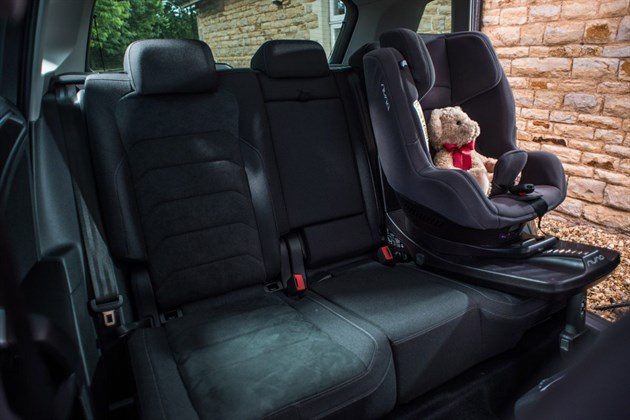
Small bear has to model in place of actual child who was at nursery...
Let's start with the rear seats. Because for me this is where the Tiguan stands out from the competition. We have one of those big 360 swivelling car seats - a Joie Spin - and it takes up a lot of room. We're using it forward facing which saves us a bit of space, but it's still a bulky thing. But in the Tiguan, we can actually have the front-seat passenger seat in a comfortable position - and still leave enough room for our daughter's feet. It's nice to drive along without the constant kicking from a pair of wellies on the back of your seat.
That's a big change from the DS4 Crossback I ran where the passenger had to have their knees bent up against the dash in order to give room for little legs behind. The boot is a winner too. We have the electric tailgate on our car (part of the £660 keyless entry pack) and it opens to reveal a wide and square boot space with only a small load lip. We can get our pushchair in there and a few bags of shopping on top but, while it's good, it's still not as useful as the Octavia vRS Estate we had previously.
But the Tiguan does excel is when it comes to comfort. With the smooth, albeit far from economical, TFSI petrol engine and seven-speed DSG gearbox it goes along effortlessly and quietly. When you have a sleeping toddler in the back, that's very much a good thing.
So after a week driving a variety of cars, it's always nice to get back into the Tiguan. True it's not that exciting, but it's reassuring, relaxing and easy to drive. And for a family car that's exactly what I want.
Volkswagen hits the infotainment nail on the head
Easy to use, a good layout and pin sharp graphics. Volkswagen has - for our money - the best infotainment system around.
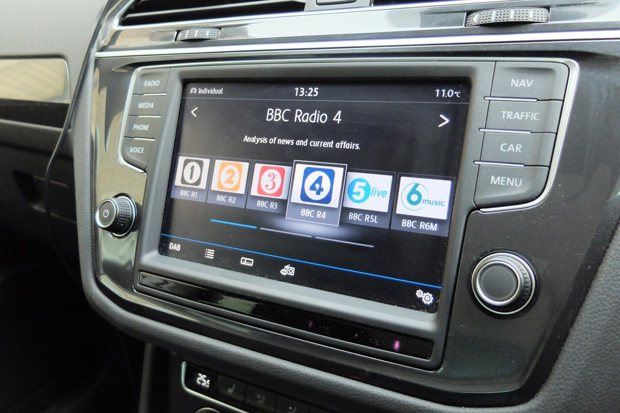
Date: 20 July 2017 | Current mileage: 993 | Claimed economy: 38.2mpg | Actual economy: 28.5mpg
First off, cards on the table here - I hate the word infotainment. It's truly horrible, both to read and to say. But given the number of features controlled via the central touchscreen that's become the norm on modern cars, there's a bit more than just listening to Radio 5 Live. So I can no longer refer to it as just the 'stereo' which also makes me sound like someone stuck in the 1990s. Hence the 'i' word.
Back then the height of technology was having a minidisc player in your Lexus along with a CD player. Wow. It was truly the future. I remember getting excited by my new Kenwood head unit in my old Vauxhall Astra which let you change the background colour to match the dials in your car. That was how to impress your mates on a night out.
How things have changed. The touchscreen now does much more than just turn the radio down - it's instead become the main way to interact with your car, letting you set the climate, alter drive settings, change the colour of your ambient lights and pretty much anything else you can think of.
It's been good news for car designers. It means far less buttons to clutter up their nice interiors but despite being an integral part of any new car, it's still surprising how many manufacturers still manage to get infotainment systems wrong with dull graphics, slow software and confusing menus.
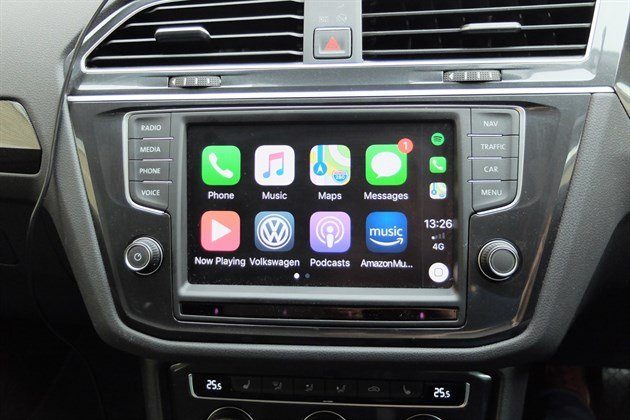
Apple CarPlay works well in the Tiguan. Ooo, I've got a text message...
Luckily, Volkswagen has got it spot on with its latest system which you'll find not only in Volkswagen models, but of course Audi, Skoda and SEAT too. Even a Bentley. It's up there with the latest Volvo system which debuted on the XC90.
So why is it so good? Well it's just very intuitive and easy to use. It swipes left and right like a smartphone and responds just as accurately when you tap on an icon. That's not something that can be said of the system in the Land Rover Discovery Sport.
The navigation is another highlight - although finding postcodes is a bit hidden away - but the POI function is excellent and has pretty much every place I've looked for. That's rarely the case on other cars. It also does that thing I like where it gives you three different routes to choose from.
On a purely aesthetic front, the menus and graphics look good too. Especially all the logos for the different radio stations. Plus as we've come to expect, it comes with Apple CarPlay which means I can connect my iPhone and listen to Spotify or Audible on the drive to work.
Is it time for a plug-in hybrid Tiguan?
Going for the 2.0-litre petrol engine in our Tiguan does mean sacrificing economy, would a plug-in hybrid be the answer?
Date: 3 August 2017 | Current mileage: 1121 | Claimed economy: 38.2mpg | Actual economy: 28.9mpg
While there seems to be a big backlash against diesel of late, there's no denying that if you want economy, nothing can match a diesel engine for big mileages. But the kind of driving our Tiguan does - around town with lots of short journeys - is not good for a diesel engine. The only alternative in the Tiguan is a petrol engine - there's no hybrid or electric version yet.
Of course going for petrol inevitably means economy won't be as strong. Our 2.0 TFSI returns a claimed 38.2mpg which isn't too bad given it's an engine with 180PS that's also fitted with four-wheel drive and an automatic gearbox. But for comparison, the same engine in an Audi A5 Coupe has an official economy figure of more than 52mpg - and that's with the same automatic gearbox.
Those claimed figures are never going to be achieved in real world driving (although there are some rare exceptions) so seeing that our Tiguan is averaging less than 30mpg, should we really be surprised? At the moment it hovers between 28mpg and 29mpg - and it's not a car that's ever thrashed around. But then it rarely sits at a steady 60mph or 70mph either.
What would be ideal for our kind of use would be a hybrid. At the moment you can get a plug-in GTE version of the Golf and Passat, but not the Tiguan. The only plug-in hybrid SUV in the Volkswagen Group is Audi Q7 e-tron. That starts at £66k...
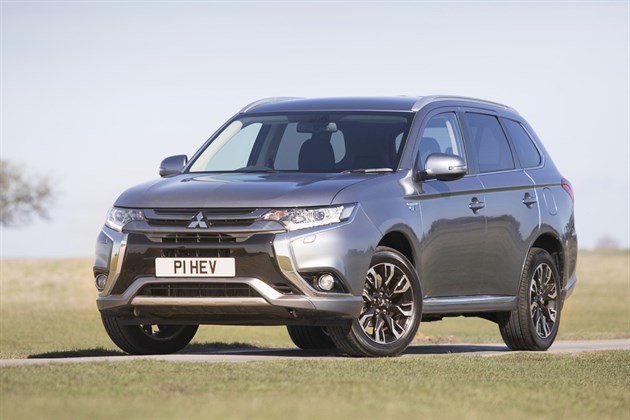
Is it time for Volkswagen to follow Mitsubishi's lead?
Plug-in hybrids are few and far between at the moment - and even more so if you're narrowing it down to Tiguan-sized SUVs. The Mitsubishi Outlander is probably the best know PHEV model and very affordable alongside the competition, starting at £32k.
There is also the new Volvo XC60 T8 but like the Q7 e-tron, it's at the top end of the range. In fact it costs close to £58k. You could go smaller with the MINI Countryman or bigger with an X5 xDrive40e but there's not much else out there.
That means for now I'm going to have to settle for 29mpg in our Tiguan. Which doesn't look good on paper but given that the car does relatively few miles, isn't actually too bad at all. It has a 58-litre tank which gives it a range of 370 miles. That usually does us for a few weeks, so it's not as if I'm constantly filling it up either.
Judging by Real MPG, the figures we're seeing on our Tiguan are pretty much spot on with that other owners of the 2.0 TFSI are seeing, so that's at least some comfort. And Mitsubishi Outlander PHEV owners? Well at the moment it stands at more than 59mpg...
Thule roof box to the rescue
Our Tiguan isn't short of space yet we still manage to cram it full of stuff when it comes to going on holiday. Will a shiny new Thule roof box be the answer?

Date: 22 August 2017 | Current mileage: 1481 | Claimed economy: 38.2mpg | Actual economy: 29.3mpg
Despite having a pretty enormous boot, I still somehow manage to find myself short of space in the Tiguan. The fact I'm carrying around a now rarely used pushchair for a two and a half year old is part of the problem. But you can guarantee that the day I take it out is the day my daughter decides she wants to go back in it...
It's not too bad on a day to day basis, but when it comes to weekends away or a holiday, the lack of space soon becomes apparent. How my mum and dad coped in the late 70s with two children and a Volkswagen Variant I'll never know.
Not that the Tiguan is exactly short on space. The boot totals 615 litres which is 185 litres more than a Nissan Qashqai and considerably more than a BMW X3 too. It's got some neat touches too, like little levers to flip the seats down and useful hooks which stop your shopping bags rolling about on the mini roundabout outside Sainsbury's.
But when it comes to holiday, those buckets and spades need to go somewhere, plus other not-as-essential stuff like a travel cot. And nappies. The solution? A roof box. Yes, I've turned into one of 'those' people already. I'll be wearing a fleece before the year is out. And I already own a pair of shoes I describe as 'sensible'.
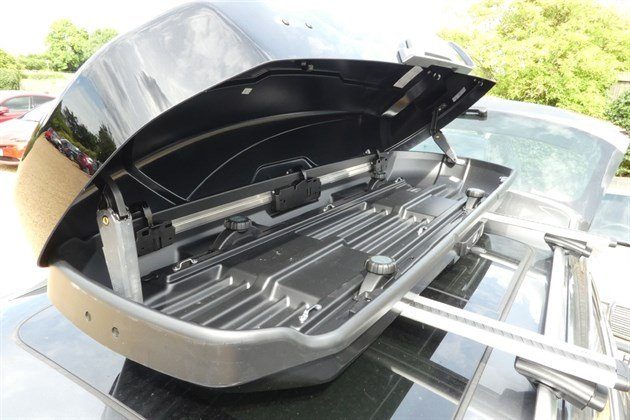
This extra 300 litres quickly gets filled up...
However, as I've discovered while searching for the internet while sipping my flat white, things have changed in the world of roofboxes. Mainly thanks to Thule, which is surely the grand daddy of roof box makers. If such a thing exists. Because Thule now makes some sleek looking roofboxes - well as sleek as a roof box can be.
I've gone for a Thule Motion XT Sport. Which sounds impressive before it''s even arrived in its massive box. It's a fairly narrow box but it still offers an extra 300 litres of space and mean I can store away stuff like a folding McLaren pushchair. Plus various soft toys, sorry Treetop the Lion. I did at least put them in a nice bag.
I was fully expecting a big, ugly and wobby roof box. But this Thule is nothing like that. It's sturdy, robust and the design actually looks pretty good. Crucially, it doesn't actually create too much wind noise either and although fuel economy has fallen by about 1mpg with it on, that's probably down to the fact that I have a car full of stuff too.
It does mean the panoramic sunroof is now useless, unless you want to see what the underneath of a moulded plastic roofbox looks like. And the novelty of that soon wears off. But that's a small price to pay for the extra space it offers. I just have to remember not to park in any multi-storey car parks now.
An optional extra that I never ever use
We ordered our Tiguan with the Head-Up Display for an extra £500. But we really think we should have saved our money...
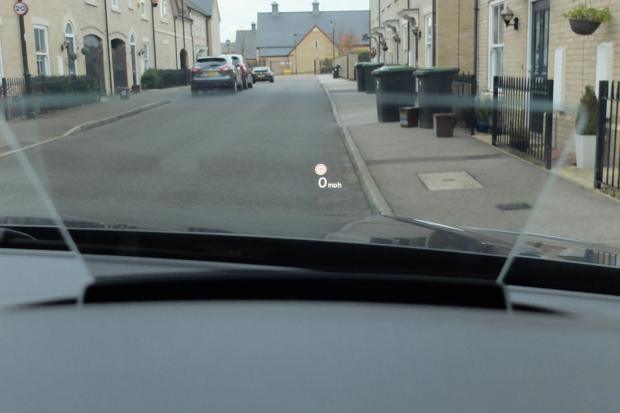
Date: 5 September 2017 | Current mileage: 1991 | Claimed economy: 38.2mpg | Actual economy: 29.0mpg
When I ordered our Tiguan I tried not to be too trigger happy with the optional extras. The SEL trim of our car means it's already £32,975 to start with. True it is a very well equipped model (which you'd hope given the price tag), but there were still some things that I thought were useful additions.
Despite my attempt at being restrained, I still managed to knock the price up by more than £4000. A large part of that is the upgraded Discover Navigation Pro system which is an extra £1390. Ouch. Keyless entry is £660 and includes a start/stop button plus the electric tailgate - something that's somehow become the norm for us (we've changed...).
There were two other things I went for that cost a bit. One was the Dynamic Chassis Control - or DCC as Volkswagen shortens it to - which cost £810. It means you can change the suspension settings from normal to either sport or normal. And how many times have I used it since I've had the car? That's right, once. On the first day I got it.
The second was the Head-Up Display which cost an extra £500 - one of those systems that projects driving information (well, speed mainly) onto the windscreen. Back in the 1980s, when I was a young boy - the idea of something like this was pure science fiction. I mean, we were blown away by a digital dash, something which the Vauxhall Senator made reality. I know because for some reason I own one...
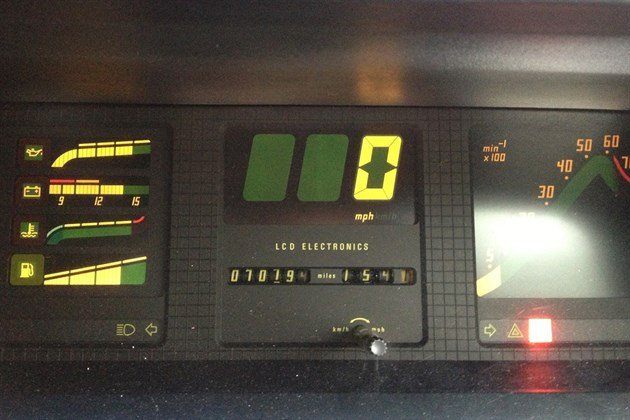
This was the future. In 1985. If you owned a Vauxhall.
I say the Tiguan projects information onto the windscreen. It doesn't actually. Volkswagen has gone for a halfway house with the Tiguan so instead it uses a little pop up bit of perspex. So it's not quite as posh as those systems you get on an Audi or BMW.
I know a lot of people see them as a gimmick, but I've also found them very useful as an immediate 'in your face' reminder of your speed. There's no excuse for the old 'I didn't realise how fast I was going' excuse. But for some reason I just can't get on with the one in the Tiguan. Maybe it's the odd plastic pop-up screen, but I find it quite distracting.
There is also the small fact that our Tiguan has the Active Info Display - the Volkswagen version of what Audi grandly calls the 'Virtual Cockpit'. It basically replaces the conventional analogue dials with a digital display which you can configure. And it has a big digital speedo on one side, which has sort of made the head-up display redundant.
So essentially what I've done here is picked a £500 option that sounded good, but in reality I never use. Which I readily admit is my own fault. Add in the DCC - which again is something I rarely utilise - and it appears I'm very good at wasting money on things that aren't needed. This is why I have to disable in-app purchases on my iPhone...
Is the Ateca a better choice than our Tiguan?
The Ateca was the most popular car on our site in 2017. It's also cheaper than our Tiguan - so is it a better choice?
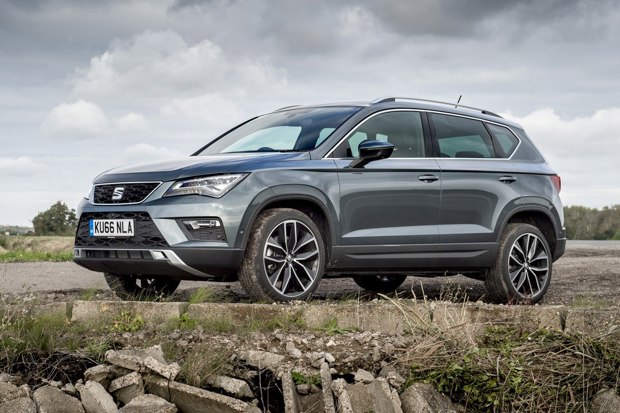
Date: 19 September 2017 | Current mileage: 2269 | Claimed economy: 38.2mpg | Actual economy: 29.2mpg
Even without knowing that SEAT is part of Volkswagen Group, it's not hard to see the similarities between the Tiguan and the Ateca. You don't need an advanced appreciation of the finer points of car design to see these two come from the same stock.
Indeed, there's a third one coming in the shape of the Skoda Karoq which sort of replaces the Yeti - even though it's bigger (although there is a smaller Skoda crossover coming in 2019). This may seem confusing but you only have to look at the Up, Citigo and Mii to see that it somehow works.
SEAT has often aimed to pitch itself as the 'sporty' brand, compared to the more practical Skoda and a bit posher Volkswagen. It's not always succeeded - see Alhambra for evidence of that - but what it has done is position itself as a better value alternative to Volkswagen. And this has certainly made the Ateca popular. Indeed in May 2017 it was crowned our Car of the Year - the review getting more views with you, our readers, than any other in the preceeding 12 months.
It's clearly doing something right. But is it a better choice than our Tiguan? Well on paper you get a lot more Ateca for your money. The list price of our (admittedly high spec SEL) Tiguan is £33k - and that's without options. For that money you can have any Ateca you want, the most expensive model is £31,260.

Well this all looks very familiar...
That money gets you an all-singing and all-dancing Ateca Xcellence which comes with a rearview camera, heated seats, leather upholstery and full LED headlights among a long list of other stuff. Our Tiguan SEL doesn't get a camera nor leather as standard. The Ateca looks much better value for money here.
You can also get the same 2.0 TFSI engine and automatic DSG gearbox with four-wheel drive in the Ateca. And you'll be saving £3000 in the process. So does it feel a cheaper car? Well as with the outside, it's all very familiar inside the Ateca. That said, there is something about the Volkswagen that makes it feel that bit better. Maybe it's the feel of the switches and buttons, or the nicer plastics on the doors and dash, but it's that little bit more upmarket. Not £3k's worth though...
But on the move, the Volkswagen feels noticeably quieter and more refined than the Ateca. That's not to say the SEAT is poor, far from it. However, the Tiguan rides that little bit better and there's less noise too. Elsewhere, however, the two handle and drive very similarly. The Tiguan also has the more versatile rear seats. They recline and slide back and forward - the Ateca has a fixed bench. The Tiguan has a slightly bigger boot too, but neither is exactly short on space.
I have to say, the Ateca really impressed me and at £3000 cheaper than the equivalent Tiguan it looks very good value. Yes an Ateca won't be worth as much as a Tiguan on the second hand market, but it won't be £3k less. If it came to a chocie with my own money between the two - the Ateca would be hard to resist. Sorry Tiguan...
Can boring actually be a good thing?
Despite its talents, our Tiguan is hardly the stuff of excitement. But does that matter when it comes to a family crossover?
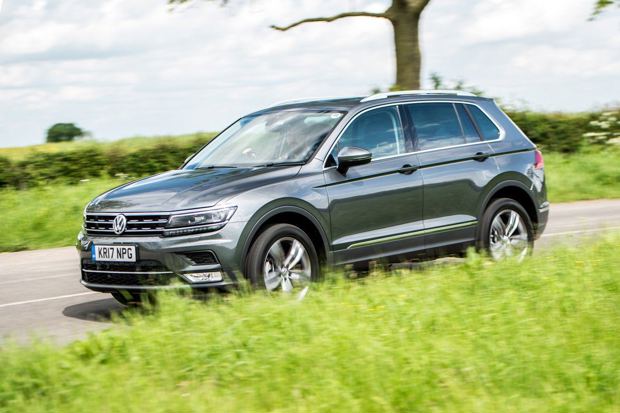
Date: 10 October 2017 | Current mileage: 2533 | Claimed economy: 38.2mpg | Actual economy: 28.7mpg
There's a lot to like about our Tiguan. It's very comfortable, very quiet and very easy to live. It's one of those cars you can just jump in and drive. Which when you're running late for the school run (well, nursery run in my case) is very handy. But the thing is, it's just a bit, well... boring.
Maybe I'm expecting too much. This is a family crossover after all - if I wanted interesting I could go and get something like a Focus ST right? But the thing is, interesting crossovery-sort-of-SUV things do exist. Only they're called the Porsche Macan and cost at least £45k.
I've covered lots of miles in the Tiguan over the past two weeks, plenty of it on motorways and dual carriageways. It really is a lovely and smooth thing to drive. True, our TFSI does lack the in-gear pulling power of a diesel, which means you occassionally have to plant your right foot down in order to get it to shift along.
It's no ball of fire, but once you're cruising along it's hushed and relaxing. And everything works so well inside. We've had no issues at all since our Tiguan arrived - the only glitch seems to be when Apple CarPlay doesn't work first time around, but unplugging it and reconnecting seems to fix it. But it could just be my phone or pesky Spotify.
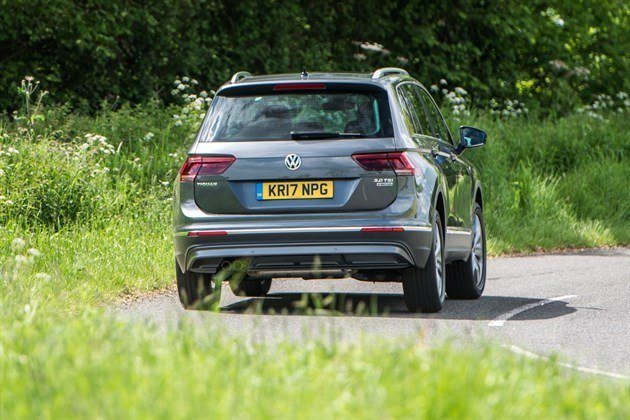
Attempt at an excitingly dynamic photo...
For someone looking for a quality and plush crossover, the Tiguan is an easy car to recommend. But for me, I just find it all a bit bland. Perhaps it's because I'm fast approaching the big 4-0 and am close to having a mid-life crisis - only without the Mazda MX-5 and baseball cap. Yes, the Tiguan is very good, but it never puts a smile on my face.
Maybe I'm in a minority here. Is there the demand for a genuinely enjoyable-to-drive family crossover that's also affordable? Maybe when Skoda launches the Karoq - its version of the Tiguan, there will be a vRS version, although I won't be holding my breath.
My drive to work is a very boring one. There's 40 miles of drab A1 and then the last five miles is quiet country lanes. The 'fun bit' as a I call it. Would I sacrifice a bit of the comfort and quiet over 40 miles of motorway for some enjoyment on that last five miles? You bet I would.
Ultimately, modern cars are designed to appeal the widest range of people. The handling and driveability of something is becoming less of a concern. As long as it goes around a corner and stops, that's enough. Me? I'm still of the old school. Yes I can appreciated why the Tiguan is good, but deep down I'll always want something that I'll look out of the kitchen window at - and smile.
Dynamic chassis control - a worthwhile extra?
Our Tiguan is fitted with DCC - an £810 option - but while it may be very clever, is it worth paying the extra for?

Date: 24 October 2017 | Current mileage: 2890 | Claimed economy: 38.2mpg | Actual economy: 28.9mpg
We recently got asked a question by one of our readers who was buying a new Tiguan. Is Dynamic Chassic Control worth paying extra? The reader in question lived in a rural area with poor quality roads so ride quality was a key feature they were looking for. Now at £810, the DCC option is not cheap, but it is something we went for on our car.
If you don't know what DCC does, it adapts the suspension as you drive along using electrically controlled dampers and steering. Sounds fancy. But from behind the wheel what it should mean is a more settled ride on poor surfaces.
There's another element too. You can change the set-up from normal to either comfort or sport. As you'd expect, the former softens everything up and the latter makes it all a bit firmer. Volkswagen even claims that the result is 'like driving an agile sports car.'
So is it? Well no, funnily enough. Yes it does make the steering a bit quicker and sharper, but there's no getting away from the fact this is a family crossover. The sport mode in DCC may be good in a Golf GTI, but in the Tiguan it's pretty pointless. So much so that I have never actually used it apart from the purposes of testing it out...
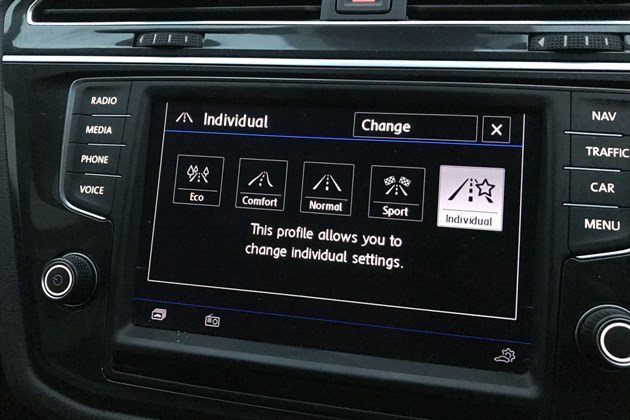
You can change the driving modes of the Tiguan with an individual setting
So what about comfort? Well, it won't shock you to find that this makes the Tiguan a bit softer over rough roads - and noticeably so. Certainly on some of the poor rural roads near me, I've found the comfort setting makes quite the difference.
The question is, is it £800 worth of difference? Having driven a Tiguan with standard suspension I think that you're better off saving your money. The Tiguan rides well enough without DCC that there's really no need to fork out the extra.
And even though I specified DCC in our car, I've never actually used either of the sport or comfort settings in anger so to speak. It stays resolutely in the standard setting where - for me at least - it's pretty much spot on.
That's not to say DCC isn't an impressive bit of kit. It's very clever and does make a difference to the overall comfort level. But given how much it costs, I think the standard suspension is a better bet. Maybe that's credit to the Tiguan for being such a comfortable car to start with.
A Tiguan with seven seats - that will be the Allspace
If you're after a Tiguan but need seven seats then there's an answer in the shape of the new Tiguan Allspace.
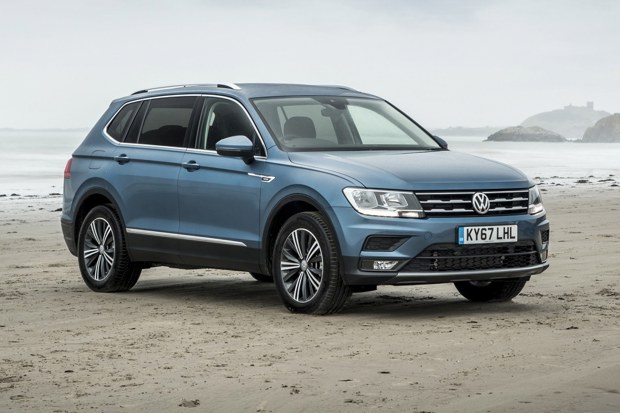
Date: 8 November 2017 | Current mileage: 3125 | Claimed economy: 38.2mpg | Actual economy: 28.7mpg
Having a seven seat car used to mean going for a some sort of van with rows of seats that was one step away from a minibus. Or one of those estates - like a Mercedes E-Class - that had two rear facing seats stuck in the boot that looked terrifyingly unsafe. Thankfully, things have moved on (particularly in terms of safety) and if you need seven seats, there's far more choice these days.
And amongst those are plenty of SUVs. Indeed, if a big SUV doesn't come with at least the option of seven seats these days, it's a rarity. The Hyundai Santa Fe, Nissan X-Trail and Skoda Kodiaq all come with a third row of seats, to name but three of the more affordable models.
Strange then that Volkswagen hasn't offered anything similar - the Touareg is a five-seater only. That is until now. Step forward the Tiguan Allspace. This isn't merely a Tiguan with some extra seats in. Instead it has a stretched wheelbase and sits around 20cm longer. In fact it's pretty much indentical in length to the Kodiaq - funny that.
And like the big Skoda, the middle row of seats can slide forward and back while all the rear seats can be folded down flat. Standard boot space is 700 litres - put the third row up and there's still a useable 230 litres. That's compared to 615 litres in our Tiguan.
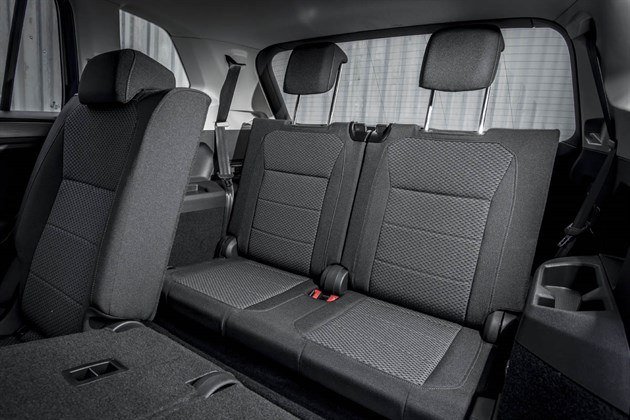
This is no way looks all grey and depressing...
The picture above shows the all important extra row of seats. And as you can see they're the usual 'occassional' type that most SUVs come with. A bit flat and a bit firm. Fine for kids on short journeys but you wouldn't want to be stuck there for hours on end. Unless you really hate your own knees.
But it does add that extra bit of flexibility to the Tiguan and in the Volkswagen range this is the only seven-seater that's not an MPV. It also comes with the same engines as the normal Tiguan, although there are no entry-level S or SE models. And you'll be paying around £2500 to £3000 more the privilege.
In fact you'll be able to find out what we think of the seven seat Tiguan Allspace next year. When our Tiguan goes back it will be replaced by an Allspace - this time with a TDI diesel engine. And our Mark Nichol will be running it. In the meantime, our Tiguan is coping well with horrible weather and is especially reassuring when it comes to coping with standing water and some of the flooding which has affected the rural roads near me.
After the Tiguan goes back I will be returning to an estate. I love those. It's sadly not an Octavia vRS, a car I still miss, but it is something a little bit special. Until them, I'm enjoying the quiet calm of the Volkswagen, even if the economy is still a sore point...
We say goodbye after six months with our Tiguan
Our Tiguan has proved faultless over the last six months so we're sad to see it go.

Date: 30 November 2017 | Current mileage: 3552 | Claimed economy: 38.2mpg | Actual economy: 28.6mpg
As car ownership goes, the last six months with our Volkswagen Tiguan has been uneventful. Not in a bad way you understand, but I wouldn't go as far to say it's been thrilling. Rather the Tiguan has proved faultless, reliable and basically an easy car to live with day to day.
That's quite an underrated quality. I like the fact the Tiguan is a car I can just jump in and drive. It's not exciting, but it's not complex either. And this comes into its own when you're doing regular nursery school runs, going to Sainsbury's and dropping odd things off with your mum because she needs a particular pyrex dish she's left at your house.
I've owned several Volkswagen's in the past and the one thing I've always liked about the brand is how user-friendly they are. Our Tiguan has plenty of technology on board, but it's easy to use and you don't need to spend ages going through touchscreen menus to find what you want. All the buttons are obvious and even the new fangled virtual instrument display is easy to work.
It is of course practical too. And for me this is its biggest strength. With a two-and-half year toddler old in tow, things like wide opening doors, high seats and lots of rear space really come into their own. It's why crossovers are so popular now.

Comfortable and relaxing - our Tiguan is very easy to drive
In fact, the rear space in the Tiguan is comfortably above anything else similar, even the near identical SEAT Ateca. Things like the Nissan Qashqai don't come close. It's why I like the Tiguan so much. Even though it does cost more.
There are some criticisms. The 2.0 TSI engine I chose is very quiet, but not very economical. We've been struggling to anything more than around 28mpg. Yes our Tiguan has spent much of its time pottering around town with the odd jaunt up the A1, but this is why we chose a petrol as opposed to a diesel. I think it won't be too long before Volkswagen adds its new 1.5 TSI engine to the Tiguan range as a more economical alternative.
The other sticking point is the price. At £33k this is not a cheap family car. And with all the options on our Tiguan comes to more than £37k. That gets you a lot of Skoda Kodiaq and is into Jaguar E-Pace territory.
But the Tiguan still makes a strong case for itself and judging by the number I see on the roads, it's proving popular with lots of other people. Although all the others seem to be TDI diesels. But there you go. So the Tiguan may not be memorable for being particularly exciting, but it is memorable for being unextraordinary. In a good way.
